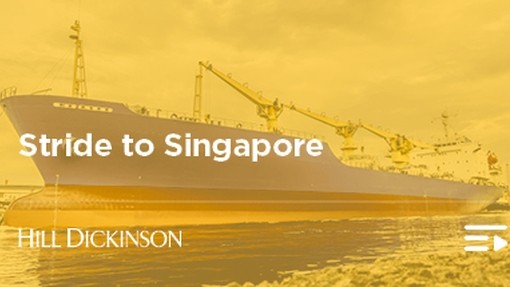Update on The Singapore Chamber of Maritime Arbitration (SCMA) Arbitration Rules: fourth edition

Details
The Singapore Chamber of Maritime Arbitration (SCMA) recently published the fourth edition of its Arbitration Rules. These will come into effect on 1 January 2022 and apply to any SCMA arbitration commenced after that date.
The SCMA was formed in 2004, initially as part of the Singapore International Arbitration Centre before being reconstituted as a freestanding entity in 2009, when the second version of the Rules was introduced, later being updated in 2013. The previous third edition of the Rules was introduced in October 2015. The significant increase in both the electronification of legal practice and the more recent widespread normalisation of, for example, video-conferencing technology mean that the latest update to the Rules is both timely and important. Additionally, there has been a significant growth in the number of arbitrations carried out under the SCMA rules since then. The updating of the SCMA Rules follows closely on from the updating of the London Maritime Arbitrators Association (LMAA) Terms with effect from 1 May 2021, which also contained extensive provisions for remote and semi-remote hearings following the Covid-19 pandemic.
The introduction of the third edition of the Rules was intended to increase to a greater extent party autonomy and align closer to the traditional approach to maritime arbitration as exemplified by the LMAA as opposed to the more formalistic approach taken by, for example, the International Chamber of Commerce for commercial arbitration. That trend continues with the introduction of the fourth edition, which was produced after a public consultation from parties with an interest in the SCMA. The SCMA has further described the key philosophy behind the new Rules as promoting a user-friendly, cost-effective, efficient, and fuss-free approach to the resolution of disputes.
We set out below some of the examples as to how those intentions have been put into practice.
Key changes
- New ‘Expedited Procedure’ for claims up to USD 300,000
- Gender neutral language
- Clear provision for service by email
- Arbitrations to be notified to SCMA
- Greater controls on witness and expert evidence
- Potential for two-person tribunals to issue awards
- Provision for electronic hearings
- No need for a hearing unless requested by a party
Expedited procedure
The 2015 Rules contained a Small Claims Procedure which applied to claims in which the aggregate amount or the claim and/or counterclaim was less than USD 150,000. The Small Claims Procedure provided for a sole arbitrator, capped tribunal fees of USD 5,000 or USD 8,000 in the event of a counterclaim, capped legal costs of USD 10,000 per party, and a reduced timeframe. The default position was that the tribunal would proceed directly to an award (to which no reasons need be appended) based on the statements of case, but the possibility of an oral hearing was left open.
The Expedited Procedure in the new Rules applies to claims up to a substantially increased aggregate amount of USD 300,000. The timeframe of the arbitration is reduced in the same way it was under the Small Claims Procedure, but now the provision for a hearing is only if the tribunal so requires. The tribunal is now to include brief reasons when making its award. The capped costs for the tribunal and lawyers are no longer included within the rules but within a separate Schedule of Fees available on the SCMA website. From 1 January 2022 the Schedule of Fees operates on a tiered basis, with disputes under USD 200,000 being capped at USD 10,000 for the tribunal and USD 15,000 per party. In the event that a dispute is quantified between USD 200,000 and USD 300,000 then 5% of the amount by which it exceeds USD 200,000 is added to each of those caps.
The USD 300,000 dispute limit for the Expedited Procedure is double that of the LMAA Small Claims Procedure, although the fee caps are more than double. The dispute limit is more comparable to the LMAA Intermediate Claims procedure which applies to claims between USD 100,000 and USD 400,000 but which still allows for a full tribunal, and which limits costs to a maximum of 50% of the claim/counterclaim, in the event of an oral hearing. As a result the SCMA Expedited Procedure fills something of a gap in the arbitration market, allowing parties to (agree to) resolve disputes between them at much higher levels, whilst still keeping exposure in legal costs, in the event of the other party prevailing, within fairly strict fee caps.
It open to the parties to agree between them that the Expedited Procedure shall apply to claims of any quantum, and the new Rules expressly contemplate this. However, in practice is it quite rare for contractual arbitration agreements to alter the applicable rules substantively.
Electronic service
Rule 3 of the 3rd Edition (the ‘2015 Rules’) acknowledged that written communications could be effected by email, but mandated that service of any substantive notice for the purposes of the Rules was only deemed received once physically delivered.
In the fourth edition (the ‘new Rules’) any notice or communication can now effectively be served by email, to the addressee’s designated electronic mailing address, in addition to the traditional methods. The designated mailing address need not be a specified desk within the receiving party (absent written agreement) but can be any email address used between the parties in the course of the matter in dispute.
Notice of arbitration and appointment of tribnal
The Notice of Arbitration is now to include a brief statement of the nature of the claim, which was previously only optional. The requirement to include an indication of the quantum of the amount of the claim is still only required ‘where possible’. The Notice is to also now include a comment as to whether the new Expedited Procedure is to apply. The provisions concerning the Response to the Notice of Arbitration are also now more prescriptive, and also require a brief statement describing the nature of the respondents’ defence.
The stricter requirements for the contents of the Notice of Arbitration and Response to Notice of Arbitration, seemingly intended to better inform the parties (and the SCMA) of the dispute, may risk causing more issues than they solve. In our experience it is rare for the parties not to be aware in general terms of the dispute between them. However, in mandating that the Notices shall include, for example, a ‘brief statement’ setting out that party’s case the Rules introduce the potential for more regular disputes about the validity of Notices of commencement. While we doubt that the use of the word ‘shall’ would be enough to make compliance imperative, we can envisage potentially costly arguments arising as to whether commencement was valid or whether a claim being raised falls within the reference. Parties should in any event be mindful that additional preparation time will now be required when preparing those last-minute commencements, to ensure compliance.
The new Rules also provide that the party commencing arbitration is to also send a copy to the SCMA, although the validity of the notice of arbitration is not compromised if this is not done. The same applies to the Notice of Response to Arbitration. Although this is stated to be ‘for the record’, it is understood that the SCMA reasonably wishes to gain a clearer understanding of the number of SCMA arbitrations being conducted, given the previous clear possibility for SCMA arbitrations to conclude without the SCMA ever being made explicitly aware.
The arbitrators appointed to SCMA Tribunals are also to inform the SCMA of appointment, within 7 days of the appointment of the tribunal. Under the 2015 Rules this notification was only to cover the brief details of the dispute, but under the new Rules it is also to include the identities of the parties, their lawyers, and the quantum of the dispute. It is conceivable that some users of the SCMA Rules may not be too pleased about this for reasons of confidentiality. Further, the lack of such formalities is possibly an attraction to some of non-institutional arbitration.
A more important development is that under the 2015 Rules, if three arbitrators are to be appointed then the two arbitrators appointed are to appoint a third, with the SCMA to make the appointment if the arbitrators cannot agree. Under the new Rules, the two appointed arbitrators are now able to proceed in the arbitration without a third appointment, at least until any substantive hearing, or if they do not agree on any matter. Although Rule 8.4(c) does require the third appointment to take place before any substantive hearing, if the arbitration proceeds to award without a hearing then Rule 33.2 provides that the two arbitrators may still have the power to proceed to make an award, in addition to making any other decisions or orders.
Statement of case
Although there is no substantive amendment beyond rewording to the provisions for the statements of case, the new Rules are noteworthy insofar as they maintain the provision in the 2015 Rules that the permission of the tribunal is required for any statements of case after the Reply (and Defence to Counterclaim). As a result, the permission of the tribunal has to be obtained in order for the Claimant to serve any Reply to Defence to Counterclaim. This provision contrasts with paragraph 5 of the Second Schedule of the latest LMAA Rules, which expressly provides for submissions in reply to the defence to counterclaim falling before further permission from the tribunal is required.
Changes to the closure of proceedings are also intended to give greater certainty as to the duration of the arbitration to the parties to the arbitration. The 2015 Rules provided that the tribunal shall declare the proceedings closed at an appropriate stage. The new Rules provide that proceedings shall be deemed closed after three months from the date of any final submission or hearing, albeit the tribunal can still reopen proceedings before the final award is made. The final award is still to be made within three months from the close of proceedings.
Witness and expert evidence
The questionnaire now requires a greater level of detail as to the extent of witness evidence of fact and expert evidence on which the parties wish to rely.
In respect of witness evidence the parties must now set out not only when and who from witness evidence will be adduced, but also what subjects or issues will be covered, and the extent to which the parties have considered the potential to restrict/reduce witness evidence by agreeing facts or making admissions.
On expert evidence, the parties now have to provide further detail as to the potential for joint instruction, as well as information as to the means or procedure by which expert evidence is to be provided, including for expert conferencing. In our view this is a sensible change and will help focus the minds of the parties at a sufficiently early stage as to the evidence they will be relying on and the manner in which it will be given. In helping rein in costs in this manner, this change is consistent with the SCMA’s stated objectives.
The new Rules maintain the provision in the 2015 Rules that the permission of the tribunal is required before any expert evidence may be adduced. In this regard the SCMA procedure differs slightly from that of the LMAA, where the default appears reversed, in that the tribunal may order that no expert evidence be called, but the default position appears to contemplate the exchange of expert evidence.
Hearings
The 2015 Rules provided that there shall be a hearing unless the parties agree otherwise. That is still the effect of the new Rules, but the default appears to be against in that the Rules are now worded such that it is for the tribunal to decide whether a hearing is to be held. However, even under the new Rules, pursuant to the requirements of Singapore law, if one party requests a hearing then a hearing is to be held, whether or not a hearing is reasonably required.
The new Rules also make clear that hearings can now be held in person, by telephone, by video-conference, or in any other manner the tribunal deems appropriate. This step, mirroring global trends which fast emerged as a consequence of the travel restrictions imposed during the pandemic, even for hearings in court in many jurisdictions, will assist in reducing costs for parties to the arbitration in travel for lawyers, witnesses and parties, and the tribunal, where remote hearings are appropriate.
Comments
Considering the developments above in the whole, the initial view formed from the procedure on paper is that the SCMA appears to have succeeded in its stated goal of providing a more efficient and cost-effective framework through which disputes can be resolved. The clarity around service by email removes one regular avenue of potential frustration which can arise in other litigation forums, and the provision for remote hearings makes sure that SCMA arbitration remains current with recent imposed developments globally which help reduce costs and now feel, almost, like second nature. The increase of the quantum limits for claims falling within fee-capped litigation provides increased certainty to parties to the arbitration, and is particularly appropriate for maritime arbitration where the buoyancy of selected markets have seen dispute values increase in circumstances where the facts and principles in dispute may be familiar.






